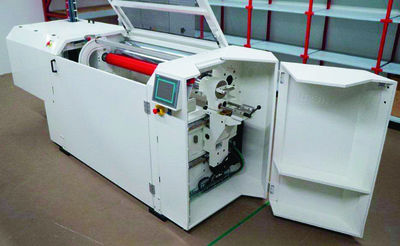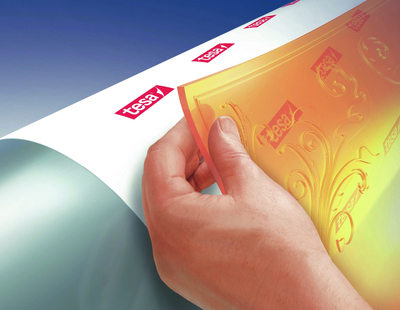tesa’s Softprint Secure with the new Snap-On adhesive
Faster press speeds, increased number of changeovers, thinner plates, the demands on the humble platemounting tape are never ending and manufacturers are meeting these with sophisticated ranges of products, and by investing heavily in R&D. By Neel Madsen.
With high demands on quality and more complex designs being printed, the challenges for flexo printers are increasing. The rise of shorter runs, especially for labels, means more changeovers increasing the time pressure, as these have to be executed fast and with great precision. As an integral part of the process, platemounting tape has to perform and cope with these pressures, and it is vital to find the correct tape for each application. Suppliers are investing in R&D to meet the demands and optimise both the tape and its application.
Bonding simulation
Under the strapline ‘The Bonding Engineers’, Lohmann can trace its roots back to 1851. Today a global manufacturer of adhesive solutions for many industries, it has an extensive range of platemounting tapes for label, flexible packaging and corrugated flexographic printing.
The company has recently expanded its flexo laboratory, the FlexoLAB, at its headquarters in Neuwied, in Germany, as part of the strategic partnership formed with Tresu.
The two companies decided to join forces in 2013. The aim of this partnership is to optimise the performance of plate mounting tapes for various situations in high speed flexography. The equipment in the new FlexoLAB includes a DuPont Microflex MS 1320 mounting machine and a print simulator with a flexo unit, which has been specially adapted by Tresu for simulation and testing purposes.
This printing simulator offers the unique capability of reproducing the relevant physical and mechanical parameters of a ‘real life’ printing job so it is possible to make forecasts about the printing result achieved by the customer. Thus Lohmann can provide customer support from initial development of a product to integration into the customer’s production process.
The concept of the FlexoLAB also enables the company to develop its own products and procedures, to optimise adhesive tape material quality and scrutinise printing press performance while assessing possible future trends. This means that it can explore the quality potential of the flexographic printing process can be fully.
The facility can also be used by Lohmann specialists to analyse a customer’s entire printing process by simulating it in the FlexoLAB, with a view to identify potential issues and fully optimise the customer’s capabilities. This includes, for example, the use of suitable cleaning agents for sleeves and plates, long run testing or the improvement of process cycle times.
Bob Drew, national sales manager UK – graphics, said, ‘Process optimisation is all the more important as the printing industry in particular is subject to keen competitive pressure: complex printing jobs, uncompromising quality requirements and narrow time frames are common place.’
Extra secure
The tesa Softprint range consists of three individual foam hardness grades (hard, soft and X-soft) and two different adhesive systems (acrylic and tackified acrylic) to suit most printing applications.
The Softprint Secure range, developed to prevent plate lifting while still offering easy demounting characteristics, has recently been extended with the Snap-On adhesive. Designed to hold down plate edges securely, even on small diameter cylinders, this bonding agent also offers easy plate mounting and demounting.
Described as resistant to common cleaning solvents, the Snap-On adhesive offers an extra strong bond, securing plate edges for maximum productivity. Adhesion promoters help to keep down plate edges with no side effects when demounting as it provides an easy release, eliminating plate damage and saving downtime.
tesa 52815, tesa 52817 and tesa 52818 Softprint Secure are available in three specifications, hard, soft and X-soft, allowing printers to select the right impression to fit the requirements of each.
Richard Eeles, strategic segment manager – flexo and corrugated markets at tesa UK Ltd, commented, ‘The flexographic print market in the UK is amongst the most dynamic in the world. With the introduction of our Snap-On adhesive technology, we are reinforcing our reputation as one of the global leaders in the marketplace and providing our customers with another tesa innovation to help their business processes and profitability.’

Lohmann has installed a printing simulator at its new FlexoLAB in Germany
Improved resilience
Within the printing and graphics market, Scapa has developed highly specialised adhesive foam tapes to ensure the high quality printing results that are essential to the flexible packaging markets.
Its Exafit HP tape gives a reliable bond to the plate or cylinder enabling longer, faster print runs with improved printing definition and reduced dot gain. A transparent PP embossed filmic liner, which is easy to remove and reposition, help reduce the number of air bubbles, essential in reducing set up times during the plate mounting process.
The range includes the addition of five new foam hardnesses. These include soft to hard foam as well as medium soft and medium hard to cover all types of applications and cope with longer print runs at high speeds for high print definition and reduced dot gain. Exafit HP also features a new type of PE foam with improved resilience, which helps to absorb any tolerances caused by variable substrate thickness and machine vibration.
Scapa explained that its Exafit HP products use specialist acrylic adhesive technology. This allows a strong contact to be maintained between the tape and the plate during the print process. The acrylic adhesive used in the range also has the added benefit of providing great solvent and chemical resistance. Specialist adhesive formulations allow for easy repositioning during the application of the plate onto the tape and clean, residue-free removal.
Applying the tape
Established in the 1970s, BiesSse SpA has developed an extensive range of double-sided tape for all sectors of flexographic printing. Based in Sedriano, in Milan, the company has branches in Brazil, Austria, the UK, India, Singapore and China.
Its latest innovation is the Pressure Roller Trolley (PRT), which has been developed to automate platemounting and solve some of the most frequent problems that arise in the process. This photopolymer mounting system has undergone rigorous testing by several leading printers. The company said that it guarantees a homogeneous and constant incremental pressure on all web and photopolymer surfaces, thus enabling correct mounting and adhesion. This allows for the issues of air entrapment and plate lifting to be overcome. Another innovative feature is that via a dedicated and user friendly software, the PRT gathers important information such as web type used, operator ID, machine type and order data (number, date, time, colour code and relative position in the machine), guaranteeing process traceability.
Marketing and communication specialist, Manuela Mazza, said, ‘Technology advances are in response to our customers’ demands. The PRT is an example of the investment that drives constant innovation and demonstrates our capacity to solve even the most challenging problems.’
On the sleeve
As an alternative to using tapes for platemounting, Polymount International has the Twinlock sleeve which employs an adhesive coating to hold the plates in place. A high quality compressible open-cell polyurethane foam ensures repeatable print results and the permanent adhesion is guaranteed for the life of the base sleeve. Tackiness is restored by simply cleaning the surface between print runs.
One of the largest producers of printed PE films in France, G’Imprim chose last year to equip its new Windmöller & Hölscher Novoflex press with Twinlock sleeves. Philippe Granger, general manager, said that along with achieving great print results, the investment in the sleeves will save him money on his tape costs and reduced time in the mounting department. Richard Kershaw, director of Polymount France, added that the use of Twinlock sleeves will also help the printer to reduce waste, making a positive contribution to its policy of becoming more sustainable.






